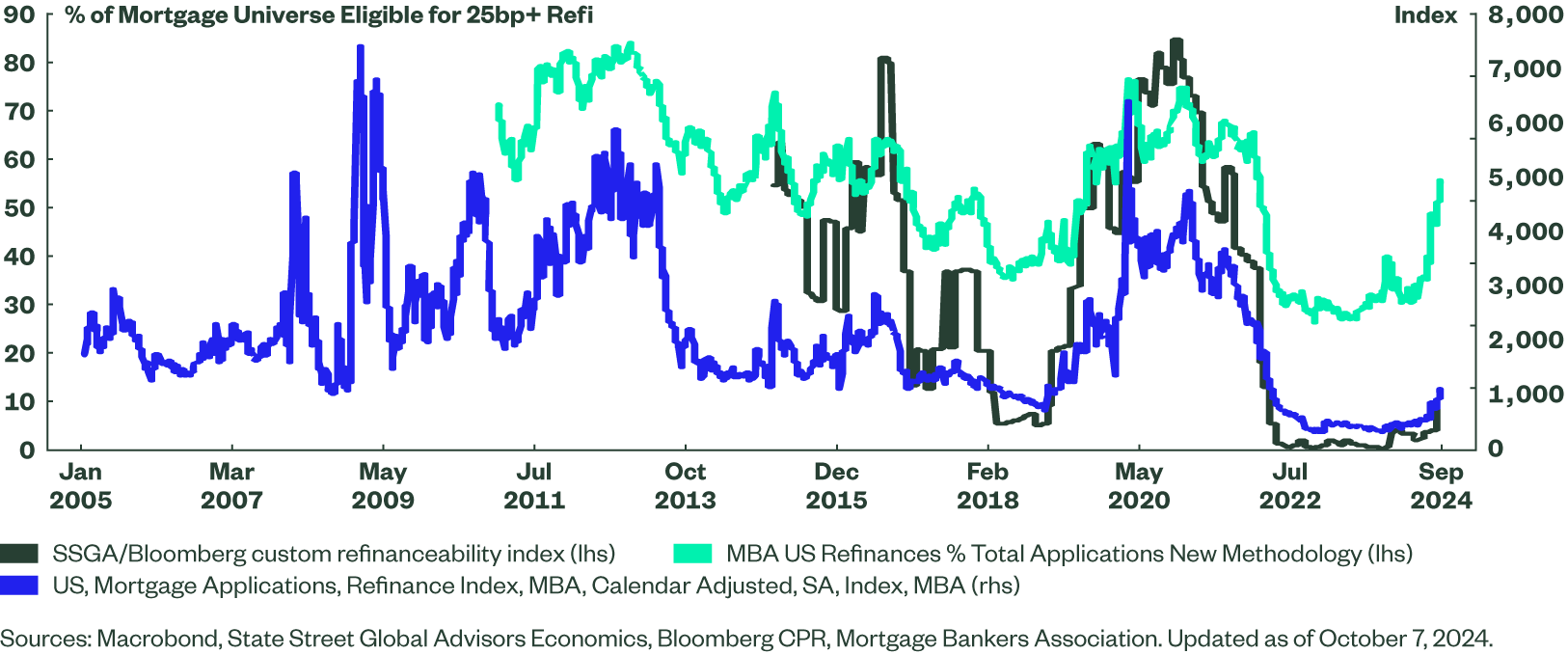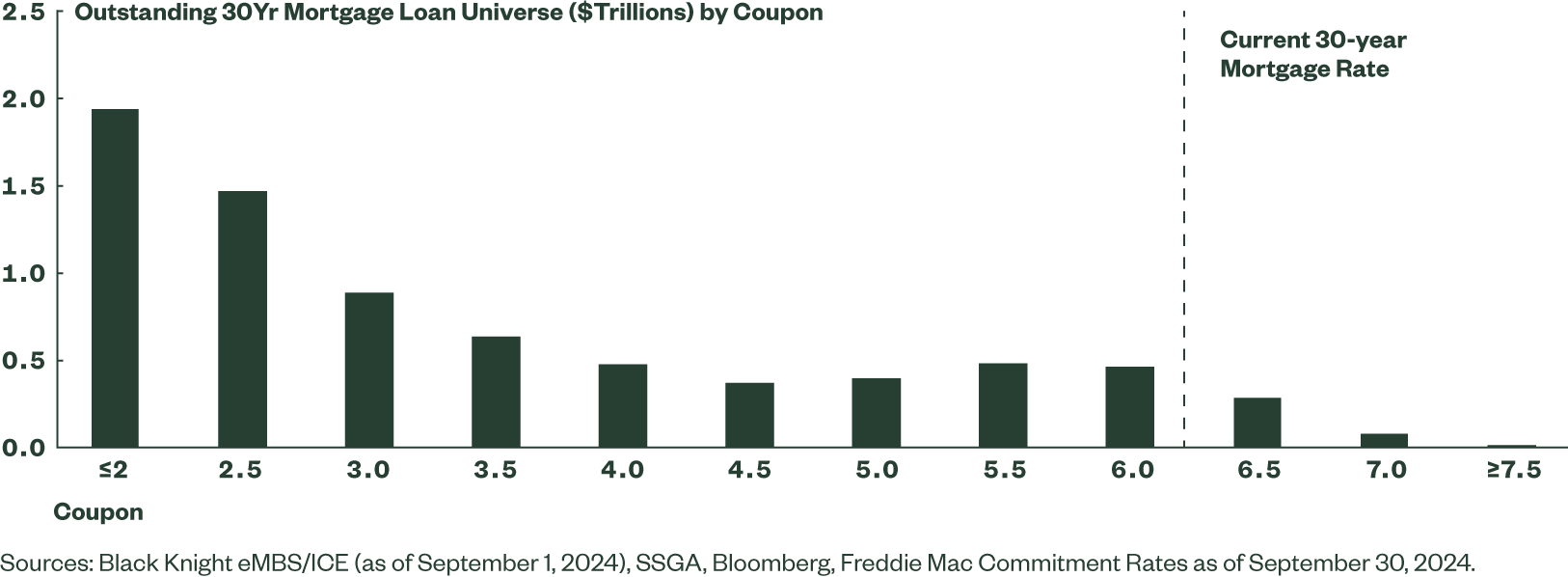An Unusual Mortgage Refinancing Cycle Ahead
The Federal Reserve’s (Fed’s) easing cycle will rouse refinancing activity in the coming months, but extreme homeowner lock-in effects1 will limit the ultimate size of this refinancing wave.
Homeowners sit on record home equity, however. Lower interest rates may lead more of them to tap into this wealth either via home equity lines of credit (HELOC) or the outright selling of their homes. All these options would incrementally release liquidity, support household consumption, and extend the economy’s soft-landing runway.
A Bifurcated Housing Market
The COVID-era zero-rate environment ushered in record low (sub-3%) mortgage rates and ignited the Great Refi Wave. That ended abruptly in 2022 when the Fed began the fastest rate hiking cycle in history. The housing market essentially froze under the twin pressures of the homeowner lock-in effect and lack of affordability. Roughly 80% of homeowners have secured a ≤5% mortgage rate and are therefore desensitized to falling rates. Meanwhile, roughly 20% of homeowners have a relatively high mortgage rate (>5%) and are ultra-sensitive to refinancing opportunities.2
Figure 1: Limited Scope For Refinancing Opportunities in This Fed Easing Cycle

By the end of September, the US 30yr fixed mortgage rate was 6.08%, roughly 170 basis points (bps) lower than its 7.8% peak last fall. During this time, we started to see the impact trickle through the traditional refinancing channel with refis accounting for about 55% of all mortgage applications, up from about 30% in May (Figure 2). Admittedly, this share has been artificially augmented by low overall lending activity.
Even with the recent revival, refinancing activity is still only back to what had marked the prior cycle low in 2018. Also, notably, as of end-September, only 14% of the total mortgage universe actually had a 25bp+ incentive to refinance. Contrast this with the late 2017 cycle when refis similarly made up ~55% of total mortgage applications, but 40% of the mortgage universe was eligible for refinancing.
Figure 2: Mortgage Refinancing is Reviving, but There Is Limited Upside

The current composition of the 30yr fixed rate mortgage universe is extremely unusual (Figure 3). The skew towards the COVID low rate loans is stark and speaks to the homebuyer lock-in effect. The subsequent float of higher rate/new production mortgages has been understandably slow to build up, and does not rival the 2-3% coupon heavyweights that still make up nearly 60% of the outstanding mortgage universe. With prepayments for the low coupon mortgages treading near all-time lows,3 the overall mortgage market configuration will be slow to change.
Figure 3: The Current 30yr Mortgage Universe is Concentrated in 2-3% Coupons

Low, locked-in mortgage rates mean housing has a higher hurdle to overcome to stimulate economic activity as rates rally with the rate-cutting cycle (Figure 4). The refi wave will be muted due to the small size of the eligible market and the magnitude of rate cuts needed to build substantial incentive.
Figure 4: Even If Mortgage Rates Rally to 4.5%, <30% of the Universe Would Be Eligible for Refi
| If mortgage rates rally to: | % of mortgage universe eligible for refinancing: | Mortgage market size impacted (USD): |
| 4.5% | 28% | 2.1T |
| 5% | 23% | 1.7T |
| 5.5% | 18% | 1.3T |
Sources: State Street Global Advisors, Black Knight eMBS/ICE as of 9/1/2024.
Refinancing in Reality
The $1.3-2T “mortgage market size impacted” numbers from Figure 4 sum up the current remaining principal balances of homeowners who would have at least a 25bp incentive to refinance in each scenario. In reality, we know that burnout and disinterest always play a role and negate some portion of that incentive. Additionally, more often than not, 25bp is too low of an economic and psychological threshold and does not strongly correlate to actual refi behavior.
Historically, homeowners have proven more incentivized to act on a 50bp refinancing opportunity. Furthermore, many recent surveys indicate that the majority of homeowners are holding onto expectations of lower mortgage rates in the near term, and many have a “magic 5%” number in mind. If mortgage rates rally back down to 5%, the borrowers with a 6%+ mortgage rate who have been patiently waiting for a substantial enough incentive will be best primed to act. According to Figure 3, these borrowers currently make up 11% of the outstanding universe with $832 billion in remaining principal mortgage balances.
Mortgage lenders appear to be aware of this homeowner mentality, and are themselves attempting to incentivize activity. As such, rising competition in the mortgage lending industry could also become a tailwind for homeowners. For example, United Wholesale Mortgage, the largest originator of agency mortgage-backed securities this year, has been front-footed with stimulating refi activity via programs like Govy125 and Refi75, as well as a 0% Down Purchase Program. Although their footprint is limited, the programs have proven successful in energizing activity on the margin.
Getting to the “Magic” 5% 30Yr Mortgage Rate
What is the path back to a 5.0% mortgage rate? The 10yr US Treasury yield has the strongest correlation with the 30yr mortgage rate, and the spread between the two rates influences the transmission of Fed rate cuts.
For decades, this spread has been firmly below 200bp, but COVID pushed that differential to linger well above 200bp. Part of this stickiness can be attributed to elevated rate volatility (the start of October is yet another case in point!) as well as a higher than usual primary-secondary spread (the difference between the primary and secondary mortgage rate, also a reflection of origination costs).
As we shift into the rate cutting cycle and mortgage loan activity revs back up from depressed levels, there is room for this differential to compress and help mortgage rates move lower. In September, mortgage rates fell 27bps and the differential compressed by about 15bps.
Since the turn of the century, a 3.25% average 10yr US Treasury yield has roughly corresponded to a 5.15% average 30yr mortgage rate (a 190bp spread differential). Given that employment in the mortgage lending industry has already downsized back to 2015 levels, the primary/secondary spread component could also start to compress as lenders compete for new business in a small refi wave. On the other hand, we acknowledge that post-COVID cyclical nuances may keep the differential slightly elevated versus historical norms. In this environment, it may take a rally to a 3% 10yr US Treasury yield to unlock the 5% “magic” mortgage rate (a 200bp spread differential).
Another Avenue for Housing Activity: Tapping Into Home Equity
Sub-3% mortgage rates were a welcome anomaly, and the desire to want to hold on to them is strong. As a result, there is a markedly higher hurdle to turnover. As we enter the long-awaited, highly-televised rate cutting cycle, homeowners may start seeking ways to tap into wealth from home equity without sacrificing their low mortgage rates. Home equity loans or home equity lines of credit (the revolving equivalent) offer a means of doing just that.
Homeowners have a record amount of equity accrued in their homes (Figure 5), and this continues to be the key source of wealth for most Americans. The ratio of households’ real estate equity to disposable personal income stands at 1.6 times,4 above pre-GFC highs. There are ways for borrowers to tap into this liquidity that start to look more enticing in a falling rate environment, such as home equity loans, HELOCs, second liens, adjustable rate mortgages, and cash-out refis. Many of these products are private market dealings, target a small eligible consumer base, and are typically slow to roll out and build up in size. Even so, altogether, they can help spur activity on the margin.
Thawing the Existing Home Market
A respite from the highest mortgage rates in two decades is a welcome development. The structural lack of supply will likely keep a floor under home prices and continue to strain affordability, capping demand (see: The US Housing Recession Is Over). Nonetheless, the current jump-off point for purchases is extremely low so there is ample room for improvement, particularly in the existing home market where activity is hovering near GFC-lows. Even if affordability only improves on the margin, lower mortgage rates should soften the lock-in effect and release some existing home inventory over time. We are already seeing this play out, with existing homes available for sale up by over 20% year-over-year in recent months (Figure 6).
The Bottom Line
The current rate-cutting cycle is expected to drive less refinancing activity than usual because lock-in effects are unusually strong. However, lower rates have already started to stir excitement in the previously frozen existing home market. Moreover, lower interest rates make it easier for homeowners to tap into record home equity, providing liquidity for further consumption. Neither catalyst on its own is poised to “surge,” but together they represent meaningful support for our long-held soft-landing macro base case.